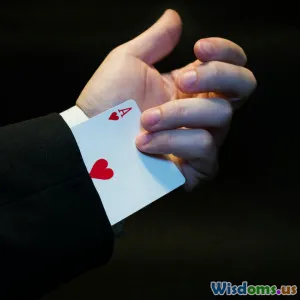
Why Do Some People Resist Illusions Better Than Others
9 min read Explore why some people naturally resist visual and cognitive illusions through psychology, neuroscience, and individual traits insights. (0 Reviews)
Why Do Some People Resist Illusions Better Than Others?
Illusions have fascinated humans for centuries, captivating us with their ability to distort reality and challenge our perception. From the mesmerizing visual illusions of artists to deceptive cognitive traps in decision-making, illusions reveal the complex workings of the human mind. But intriguingly, not everyone experiences illusions in the same way — some individuals can resist or quickly see through illusions that deceive others. Why is this the case? What determines one's ability to resist illusions?
This article delves deep into the science of illusions, exploring the psychological, neurological, and individual differences that explain why some people are better at resisting them than others.
Understanding Illusions: More Than Just Tricks
Defining Illusions
An illusion is a misleading perception or a false interpretation of sensory information. They can be sensory (visual, auditory, tactile) or cognitive (related to thought processes such as memory or reasoning).
Examples of notable illusions include:
- The Müller-Lyer illusion, where two lines of the same length appear different due to arrow-angle lines.
- The Stroop effect, a cognitive illusion displaying interference in reaction times during naming colors.
- The Ponzo illusion, wherein parallel lines converge, altering size perception.
Illusions challenge our brain's assumptions and heuristics, showcasing how perception is an interpretation rather than an exact recording.
Why Illusions Work: The Brain’s Constructive Nature
The brain constantly interprets sensory data using prior knowledge, context, and expectations. This process helps us efficiently navigate the world, but can also lead to systematic perceptual errors—illusions.
For example, visual illusions often exploit how our brains interpret shadows, depth cues, or color contrast to infer real-world properties, but under trick conditions, these inferences fail.
Factors Influencing Resistance to Illusions
1. Cognitive Flexibility and Critical Thinking
Individuals with higher cognitive flexibility — the ability to shift thinking and adapt to new information — tend to resist illusions better. They question first impressions and consider alternative interpretations instead of immediately accepting the sensory input as-is.
Supporting Research:
A study published in Cognition (2017) demonstrated that people who scored higher on cognitive reflection tests (reflecting the ability to override intuition) were less susceptible to conjunction fallacy illusions, a cognitive bias where people misjudge conjunction probabilities.
Example:
In visual illusions like the Müller-Lyer, those with analytical thinking styles critique the visual cues more and can recognize the trick behind the image.
2. Neurological and Brain Structure Differences
Modern neuroimaging has revealed that structural and functional brain differences can influence illusion susceptibility.
-
Visual Cortex Activity: Some individuals exhibit stronger responses in early visual areas, leading to more literal perception of sensory input, which paradoxically can increase susceptibility to visual illusions that exploit these neural computations.
-
Prefrontal Cortex: Higher activity in prefrontal regions involved in executive functions and top-down control correlates with better illusion resistance because they can override misleading sensory signals.
Notable Research:
A study in The Journal of Neuroscience (2019) found that connectivity between the prefrontal cortex and visual areas predicted an individual’s ability to resist the hollow-mask illusion, where a concave face is perceived as convex.
3. Perceptual Expertise and Familiarity
Experts in certain domains often resist illusions related to their expertise. For example, radiologists subjected to certain visual illusions in X-rays can detect anomalies more accurately than novices because their trained perceptual systems interpret the images differently.
Similarly, musicians show resistance to auditory illusions that confuse untrained ears, reflecting domain-specific perceptual tuning.
4. Personality Traits and Cognitive Styles
Research suggests that personalities characterized by skepticism, open-mindedness, and tolerance for ambiguity tend to resist illusions better.
- Skepticism drives questioning of initial impressions and sensory data.
- Open-mindedness allows seeing multiple interpretations and challenges expectations.
- Tolerance for ambiguity decreases discomfort with uncertain or misleading information.
Example:
A 2014 study in Personality and Individual Differences found that individuals scoring high on the Need for Cognition scale, reflecting a desire for effortful thinking, showed lower susceptibility to certain logical and perceptual illusions.
5. Developmental and Age Factors
Age impacts illusion susceptibility. Children, whose perceptual and cognitive faculties are still developing, are often more easily fooled by illusions, while adults can resist them better.
That said, aging adults sometimes become more susceptible again due to cognitive decline or reduced sensory acuity.
Data Insight:
A 2016 study in Developmental Science revealed that children under age 10 have greater difficulty resolving ambiguous illusions, pointing to the maturation of executive control and experience as key factors.
Real-World Implications and Examples
Eyewitness Testimonies and Illusions
The mind’s susceptibility to illusions doesn’t only affect visual trickery but also memory and cognition. Eyewitness accounts can be distorted by cognitive illusions such as misinformation effects. People who can critically evaluate their memories and maintain skeptical inquiry better resist these illusions.
Consumer Behavior and Marketing
Marketers exploit cognitive illusions (like anchoring or framing effects) to influence purchasing decisions. Consumers equipped with awareness and critical thinking skills resist manipulative illusions better, leading to more informed choices.
Education and Training
Understanding individual differences in illusion resistance aids in designing better education tools, promoting critical thinking and metacognitive skills to shield against cognitive biases and illusions.
Enhancing Your Resistance to Illusions
While genetics and neurobiology play significant roles, individuals can take proactive steps:
- Cultivate critical thinking: Engage in exercises that challenge your intuition and promote reflection.
- Increase awareness: Learn about common illusions and cognitive biases to identify them when encountered.
- Practice mindfulness: Heightening attention and present-moment awareness can reduce automatic misinterpretations.
- Gain domain expertise: Specialized knowledge sharpens perception and reduces illusion susceptibility in that field.
Book recommendation: Thinking, Fast and Slow by Daniel Kahneman offers profound insights into human cognition and illusions.
Conclusion
Illusions—visual or cognitive—expose the intricate dance between our sensory inputs and brain’s interpretative machinery. The degree to which people resist illusions hinges on a tapestry of factors: cognitive flexibility, brain architecture, expertise, personality traits, and developmental stages. Science illuminates that while some resistance is innate, much can be cultivated through education and mindfulness.
Understanding why some resist illusions better enriches our grasp of human perception and cognition, empowering us to navigate our world with greater clarity and skepticism. Next time you glance at a mesmerizing illusion, remember it’s not just an eye trick; it’s an invitation to unravel the extraordinary capabilities—and occasional limits—of the human mind.
Rate the Post
User Reviews
Popular Posts















